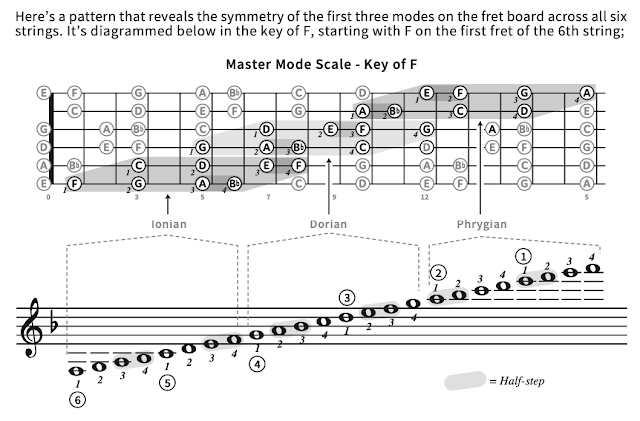The diagram above shows all seven Diatonic Modes. They are shown in the key of C, divided into two groups; Primary Modes and Mixed Modes. The three primary modes are each made up of two intervalically identical tetrachords. The four mixed modes each contain two differing tetrachords. There is symmetry within each of these two mode groups. Study the Whole-step / Half-step patterns of each mode and each group of modes, looking at them from the center outward.
Knowing the tetrachord structure of each mode greatly simplifies the learning process. In addition, the three mirror mode sets we looked at earlier enable you to learn two modes simultaneously. As we've seen, the mirror mode principle organizes the tones of specific modes into symmetrical patterns on the fretboard. This is simply an expression of their innate musical symmetry within the diatonic system.
Ionian mirrors Phrygian, Lydian mirrors Locrian, Mixolydian mirrors Aeolian, and Dorian mirrors itself.
There's really no reason to treat modes as mysterious, yet many guitarists are confused by them. Part of the reason for this is the tendency for scale patterns to be learned haphazardly. If your study of scales overlooks tetrachords and their symmetry, modes will be baffling.
Wikipedia has an interesting entry on modes; http://en.wikipedia.org/wiki/Properties_of_musical_modes
Knowing the tetrachord structure of each mode greatly simplifies the learning process. In addition, the three mirror mode sets we looked at earlier enable you to learn two modes simultaneously. As we've seen, the mirror mode principle organizes the tones of specific modes into symmetrical patterns on the fretboard. This is simply an expression of their innate musical symmetry within the diatonic system.
Ionian mirrors Phrygian, Lydian mirrors Locrian, Mixolydian mirrors Aeolian, and Dorian mirrors itself.
There's really no reason to treat modes as mysterious, yet many guitarists are confused by them. Part of the reason for this is the tendency for scale patterns to be learned haphazardly. If your study of scales overlooks tetrachords and their symmetry, modes will be baffling.
Wikipedia has an interesting entry on modes; http://en.wikipedia.org/wiki/Properties_of_musical_modes
All contents of this blog are © Mark Newstetter









No comments:
Post a Comment